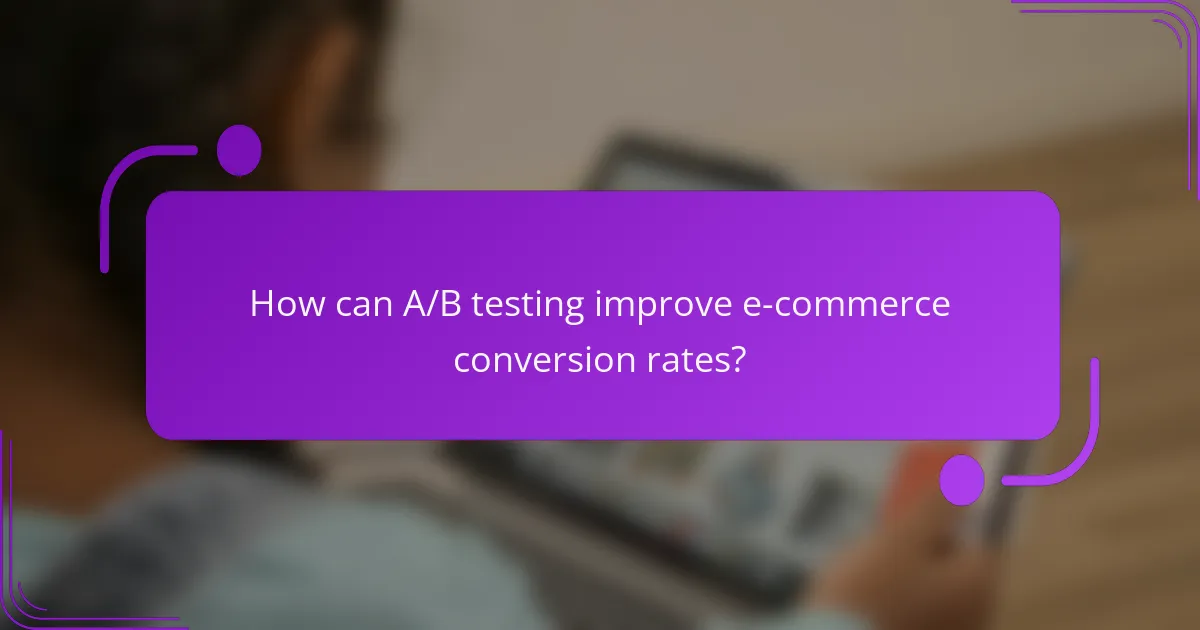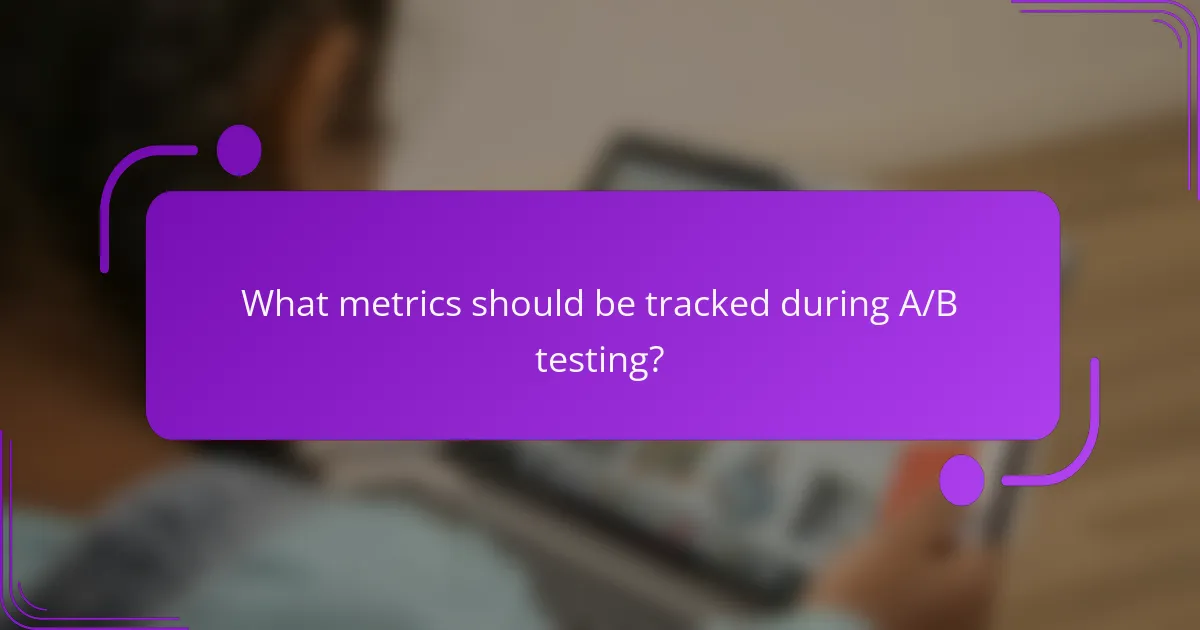Improving e-commerce conversion rates is essential for maximizing sales and enhancing customer experiences, and A/B testing serves as a powerful tool in this endeavor. By comparing different versions of web pages or marketing materials, businesses can identify which elements resonate most with their audience. Implementing effective A/B testing strategies focused on critical areas can lead to significant insights and measurable improvements in performance.

How can A/B testing improve e-commerce conversion rates?
A/B testing can significantly enhance e-commerce conversion rates by allowing businesses to compare different versions of their web pages or marketing materials. This method helps identify which variations resonate better with customers, ultimately leading to increased sales and improved user experiences.
Identifying user preferences
A/B testing enables e-commerce businesses to uncover user preferences by presenting different options to visitors. For instance, testing two different product page layouts can reveal which design leads to more purchases. Understanding these preferences helps tailor the shopping experience to meet customer expectations.
To effectively identify user preferences, consider segmenting your audience based on demographics or behavior. This approach allows for more targeted testing and can yield insights that are relevant to specific customer groups.
Optimizing website elements
Optimizing website elements through A/B testing involves experimenting with various components like headlines, images, and call-to-action buttons. For example, changing the color of a “Buy Now” button can impact click-through rates. Small adjustments can lead to significant improvements in conversion rates.
Focus on high-impact areas first, such as landing pages or checkout processes. Prioritize elements that directly influence user decisions and track the performance of each variation to determine the most effective design.
Increasing engagement through variations
Creating variations of content can boost user engagement by catering to different interests and preferences. For instance, testing different promotional messages or product descriptions can help identify which resonates more with your audience. Engaged users are more likely to convert into paying customers.
Consider using time-limited offers or seasonal promotions as variations to see how urgency affects user behavior. This can provide insights into how different messaging strategies impact engagement and conversion rates.
Measuring impact on sales
Measuring the impact of A/B testing on sales is crucial for understanding its effectiveness. Track key performance indicators (KPIs) such as conversion rates, average order value, and customer retention. This data will help you assess which variations lead to increased sales.
Utilize analytics tools to monitor performance over time and ensure that the results are statistically significant. This will help confirm that observed changes in sales are due to the variations tested rather than random fluctuations.
Utilizing tools like Optimizely
Tools like Optimizely simplify the A/B testing process by providing user-friendly interfaces and robust analytics. These platforms allow you to create and manage tests without extensive technical knowledge. They also offer features like multivariate testing and personalization options.
When selecting a testing tool, consider factors such as ease of use, integration capabilities with your existing systems, and the level of support provided. A good tool can streamline the testing process and enhance your ability to make data-driven decisions.

What A/B testing strategies are effective for e-commerce?
A/B testing strategies for e-commerce involve comparing two or more variations of web elements to determine which performs better in driving conversions. Effective strategies focus on critical areas such as landing pages, call-to-action buttons, product page layouts, and pricing strategies.
Testing landing page designs
Testing different landing page designs can significantly impact conversion rates. Consider variations in layout, color schemes, and content placement to see which combination resonates best with your audience.
For instance, a clean, minimalist design may perform better than a cluttered one. Aim for A/B tests that run for at least a week to gather sufficient data, and ensure you have a clear goal, such as increasing sign-ups or sales.
Experimenting with call-to-action buttons
Call-to-action (CTA) buttons are crucial for guiding users toward desired actions. Experiment with different wording, colors, sizes, and placements to find the most effective combination.
For example, changing a CTA from “Buy Now” to “Get Yours Today” might create a sense of urgency. Test variations in prominent areas, such as above the fold or at the end of product descriptions, to maximize visibility.
Analyzing product page layouts
The layout of product pages can influence how customers perceive items. Test different arrangements of images, descriptions, reviews, and pricing to determine which layout leads to higher engagement and sales.
Consider using larger images or a grid layout versus a list format. Track metrics like time spent on the page and click-through rates to assess which layout keeps users interested longer.
Comparing pricing strategies
Pricing strategies can significantly affect conversion rates, making them a vital area for A/B testing. Experiment with different pricing models, such as discounts, bundling, or subscription options, to see what appeals to your customers.
For example, offering a 20% discount versus a buy-one-get-one-free deal can yield different results. Analyze customer behavior and preferences to tailor your pricing strategy effectively, ensuring compliance with local regulations on pricing transparency.

What metrics should be tracked during A/B testing?
Tracking the right metrics during A/B testing is crucial for understanding the effectiveness of changes made to an e-commerce site. Key metrics include conversion rate, average order value, bounce rate, and time on page, each providing insights into user behavior and site performance.
Conversion rate
The conversion rate measures the percentage of visitors who complete a desired action, such as making a purchase. A higher conversion rate indicates that your site effectively persuades visitors to take action. Aim for incremental improvements, as even a small increase can significantly impact revenue.
To calculate the conversion rate, divide the number of conversions by the total number of visitors and multiply by 100. For example, if 1000 visitors result in 50 purchases, the conversion rate is 5%. Regularly monitor this metric to assess the impact of your A/B tests.
Average order value
Average order value (AOV) reflects the average amount spent by customers per transaction. Increasing AOV can lead to higher revenue without needing to increase traffic. Consider strategies like upselling or bundling products to encourage larger purchases.
To calculate AOV, divide total revenue by the number of orders. For instance, if your total revenue is $5,000 from 100 orders, your AOV is $50. Tracking AOV alongside conversion rate can provide a fuller picture of your e-commerce performance.
Bounce rate
Bounce rate indicates the percentage of visitors who leave your site after viewing only one page. A high bounce rate may suggest that your landing pages are not engaging or relevant to visitors. Reducing bounce rates can improve overall site performance and conversion rates.
To lower bounce rates, ensure that your landing pages are optimized with clear calls to action, relevant content, and fast loading times. Aim for a bounce rate below 40% for optimal engagement, but this can vary by industry.
Time on page
Time on page measures how long visitors stay on a specific page before navigating away. Longer durations often indicate that users find the content valuable, which can correlate with higher conversion rates. Monitoring this metric helps identify which pages engage users effectively.
To improve time on page, enhance content quality, use engaging visuals, and ensure easy navigation. Aiming for an average time on page of 2-3 minutes can be a good benchmark, but this may vary based on the type of content and user intent.

How to implement A/B testing in e-commerce?
A/B testing in e-commerce involves comparing two versions of a webpage to determine which one performs better in achieving specific goals. This method allows businesses to make data-driven decisions that can enhance user experience and increase conversion rates.
Define goals and hypotheses
Start by clearly defining what you want to achieve with your A/B test, such as increasing sales, improving click-through rates, or reducing cart abandonment. Formulate hypotheses based on user behavior and insights, like “Changing the call-to-action button color will increase clicks by 15%.”
Make sure your goals are measurable and specific. For example, instead of a vague goal like “improve sales,” specify “increase sales by 10% over the next month.” This clarity will guide your testing process.
Select testing tools like Google Optimize
Choose a reliable A/B testing tool to facilitate your experiments. Google Optimize is a popular choice due to its integration with Google Analytics, allowing you to track user interactions seamlessly. Other options include Optimizely and VWO, which offer robust features for e-commerce testing.
When selecting a tool, consider factors like ease of use, pricing, and the ability to segment your audience. Some tools may offer free plans, while others might require a subscription, so evaluate your budget accordingly.
Run tests and collect data
Once your goals and tools are set, launch your A/B test. Ensure that you run the test long enough to gather significant data, typically ranging from a few days to a couple of weeks, depending on your traffic volume. Aim for a sample size that provides statistical significance.
During the testing phase, monitor user interactions and collect data on key metrics such as conversion rates, bounce rates, and average order value. This information will be crucial for analyzing the effectiveness of each variant.
Analyze results and iterate
After the testing period, analyze the collected data to determine which version performed better. Look for statistically significant differences in your key metrics to validate your hypotheses. Tools like Google Analytics can help visualize the results.
Based on your findings, implement the winning variant and consider further iterations. Continuous testing is essential; even small changes can lead to improvements over time. Document your results and learnings to refine future A/B tests.

What are common pitfalls in A/B testing?
Common pitfalls in A/B testing can significantly hinder the effectiveness of your experiments. Understanding these mistakes can help you design better tests and achieve more reliable results.
Insufficient sample size
Using an insufficient sample size is a frequent mistake that can lead to inconclusive results. A small number of participants may not accurately represent your target audience, resulting in skewed data. Aim for a sample size that is large enough to detect meaningful differences, typically in the hundreds or thousands, depending on your site’s traffic.
To determine the right sample size, consider using online calculators that factor in your current conversion rates and the minimum effect size you wish to detect. This ensures that your results are statistically significant and actionable.
Testing too many variables at once
Testing multiple variables simultaneously can complicate the analysis and lead to confusion about which changes drove the results. This approach, known as multivariate testing, can dilute the impact of individual changes and make it difficult to draw clear conclusions. Focus on one or two variables at a time to isolate their effects.
For example, if you’re testing a new call-to-action button color and a different headline, run separate tests for each. This allows you to understand the influence of each change on conversion rates without the interference of other variables.